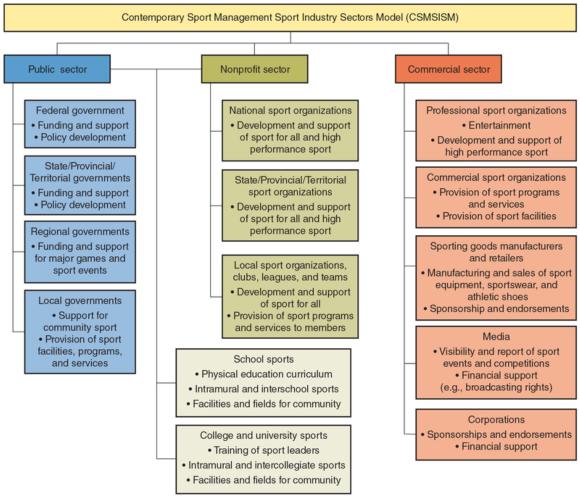The sport industry includes three organizational sectors: public, nonprofit, and commercial. These are important categories for the different types of organizations involved in sport and are central to the creation and production of sport products, services, programs, and facilities. In the following paragraphs, we explain the CSM Sport Industry Sectors Model (figure 1.1). In this textbook, sport organizations operating in the public, nonprofit, and commercial sectors are covered.

Figure 1.1 Overview of the Contemporary Sport Management (CSM) Sport Industry Sectors Model that includes the primary roles of the organizations.
The model details how three different categories of organizations contribute to the sport industry. The first category, the public sector, includes government-based units, agencies, and departments. These organizations are called public because they are created by the people and for the people. Elected officials and representatives create units to best serve the residents of a town, municipality, region, state, province, territory, or country. Governments provide facilities such as park spaces, recreation centers, and sport areas to their residents, and they develop sport and recreation programs that cater to all residents: children, youth, adults, and older adults. For example, most local governments have a parks and recreation department that provides citizens with sport programs, services, and facilities. In some countries, branches of government provide financial support to nonprofit sport organizations or provide subsidies to professional sport organizations. In addition, government agencies may develop policies to ensure that everyone has access to sport in a safe environment (e.g., girls and women, people with disabilities, Aboriginal people), policies against doping and cheating, and policies to protect sport participants (e.g., concussion policies).
The second category, the nonprofit sector, includes voluntary organizations whose main purpose is not to make a profit but rather to address a social cause, a special interest, and the needs of members. In many cases, organizations that focus on education, cultural, religious, professional, or public service operate as nonprofit organizations. Numerous sport and recreation organizations are nonprofit organizations. No one reaps financial profit from the work of nonprofits. Members of these organizations elect people to serve on the executive committee and board of directors, and these people establish the strategic direction of the organizations and fulfill the organization’s mandate. Most international, national, state, province, territory, regional, and local sport organizations operate as nonprofit organizations (e.g., the International Olympic Committee, the International Cheer Union, USA Team Handball, Ontario Tennis Federation, the Buffalo City Swim Racers).
Many primary schools, secondary schools, colleges, and universities are government-sanctioned and -funded organizations, and as a result, their mission is to serve and educate all their students. Most schools offer sports (e.g., through the physical education curriculum and through intramural sport and interschool competition), and many primary and secondary schools share their sport and recreation facilities with community groups and local sport organizations. Colleges and universities also contribute to sport through the training of future leaders in sport (e.g., physical education teachers, sport managers, exercise specialists, sport psychologists, coaches, sport researchers) through their various academic programs and offer a range of sport programs and services to their students (e.g., club sports, intramural sports, intercollegiate athletics). In some cases, colleges and universities share their sport and recreation facilities and fields with the community. In figure 1.1, schools, colleges, and universities are located between public sector and nonprofit sector organizations.
The third category, the commercial sector, is composed of organizations whose ultimate objective is generating profit. Many sport organizations and their supporters operate in this sector. Commercial organizations in sport include professional sport franchises, leagues, and other sport entities (e.g., Sky Blue FC, SKA Saint Petersburg, Los Angeles Sparks, Ultimate Fighting Championship); sport providers (e.g., downhill ski resorts, golf, fitness clubs, bungee jumping facilities, zorbing facilities, event management firms, sport marketing agencies, sport facilities contractors and operators); sporting goods manufacturers (e.g., Nike, Russell, New Balance, Head) and retailers (e.g., Dick’s Sporting Goods, Foot Locker); sport media (e.g., ESPN, NBC Sports, NFL Network, The Hockey News); and corporations that support sport with sponsorship and endorsements (e.g., Coca-Cola, Visa, McDonald’s, Budweiser). Commercial organizations are central to the operations of the entire sport industry and serve an important function to provide sport products and services to the population.
Based on the three previously mentioned models (Eschenfelder & Li, 2007; Meek, 1997; Pitts et al., 1994), we have identified the various products, services, programs, and facilities produced in the different sectors of sport and sport-related organizations that operate within the CSM Sport Industry Sectors Model. Note that some products, services, and programs are produced by organizations in different sectors; for example, high performance sport is produced by national sport organizations in the nonprofit sector and by professional sport franchises in the commercial sector. Colleges and universities also play a role in developing and producing high performance sport. Several organizations from different sectors contribute to community sport, namely nonprofit sport clubs, schools, and local governments.
Collaboration among organizations within and between sectors is central to the success of the sport industry. An example of collaboration is a national sport organization (nonprofit organization) that partners with a professional sport team (commercial organization) to promote its sport among youth. Another example of collaboration is a nonprofit local sport club working with the local government to secure access to sport facilities (e.g., swim club using the local pool to train its members and hold competitions). Through collaboration, multiple organizations with different objectives work together to grow the industry.
In addition to all the different sport organizations, there are countless stakeholders and other peripheral organizations and units that support the sport industry. Stakeholders include members of these sport organizations, sport participants, athletes, coaches, officials, administrators, leaders, volunteers, fans and spectators, corporate sponsors, media, government entities and personnel, and others affiliated with sport and nonsport organizations (e.g., talent agents, contractors, event organizers, government regulators) who can affect or be affected by sport organizations. In the following chapters, you will read about organizations from different sectors of the sport industry as well as various stakeholders.